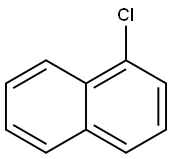1-클로로나프탈렌 C화학적 특성, 용도, 생산
화학적 성질
The chlorinated naphthalenes in which one or more hydrogen atoms have been replaced by chlorine to form wax-like substances, beginning with monochloronaphthalene and going on to the octachlor derivatives. Their physical states vary from mobile liquids to waxysolids depending on the degree of chlorination. 1-Chloronaphthalene is a colorless volatile oily liquid. Insoluble in water, soluble in carbon tetrachloride, carbon disulfide, benzene and chlorobenzene.
용도
1-Chloronaphthalene was widely used in Xylamits as a wood preservative with fungicidal and insecticidal properties in the past in Poland. 2-Chloronaphthalene was produced and used as a solvent in Poland, some of PCNs were found in polychlorinated biphenyls (PCBs) congeners.
주요 응용
1-Chloronaphthalene was used as solvent additive in the fabrication of fullerene based photovoltaic devices. It was used in preparation of polyvinyl chloride based membranes of 5,10,15,20-tetrakis(4-methoxyphenyl)porphyrinatocobalt(II) for arsenite determination. Also used in the synthesis of pharmaceutical compounds such as aryl chlorides.
일반 설명
1-chloronaphthalene is a clear colorless to amber oily viscous liquid. (NTP, 1992)
공기와 물의 반응
Insoluble in water.
반응 프로필
1-Chloronaphthalene is incompatible with strong oxidizing agents.
화재위험
1-Chloronaphthalene is combustible.
Synthesis
1-Chloronaphthalene is obtained directly by chlorination of naphthalene, with the formation of more highly substituted derivatives such as dichloro- and trichloronaphthalenes in addition to the two monochlorinated isomeric compounds: 1-chloronaphthalene and 2-chloronaphthalene.
Reaction: Using zinc as catalyst, the ratio of naphthalene to chlorine is 1:0.84-1.17, the amount of catalyst is 0.4-0.5% of the weight of naphthalene, the chlorine passage time is 3-6h, the reaction temperature is 90-95℃, the average yield of 1-chloronaphthalene is 81.7%, After secondary fractionation, the product purity is 96%. The boiling point of 2-chloronaphthalene is similar to that of 1-chloronaphthalene, the chemical properties are similar, and it is difficult to separate.
잠재적 노출
Industrial exposure from individual
chlorinated naphthalenes is rarely encountered; rather it
usually occurs from mixtures of two or more Chlorinated
naphthalenes. Due to their stability, thermoplasticity, and
nonflammability, these compounds enjoy wide industrial
application. These compounds are used in the production of
electric condensers; in the insulation of electric cables and
wires; as additives to extreme pressure lubricants; as supports for storage batteries; and as a coating in foundry use.
octachloro-: Used as a fireproof and waterproof additive
and lubricant additive. Pentachloro-: Used in electric wire
insulation and in additives to special lubricants. tetrachloro-: Used in electrical insulating materials and as an
additive in cutting oils. trichloro-: Used in lubricants and
in the manufacture of insulation for electrical wire.
Because of the possible potentiation of the toxicity of higher Chlorinated naphthalenes by ethanol and carbon tetrachloride, individuals who ingest enough alcohol to result in
liver dysfunction would be a special group at risk.
Individuals, e.g., analytical and synthetic chemists, mechanics and cleaners, who are routinely exposed to carbon tetrachloride or other hepatotoxic chemicals would also be at a
greater risk than a population without such exposure.
Individuals involved in the manufacture, utilization, or disposal of polychlorinated naphthalenes would be expected to
have higher levels of exposure than the general population.
운송 방법
UN3082 Environmentally hazardous substances,
liquid, n.o.s., Hazard class: 9; Labels: 9-Miscellaneous hazardous material, Technical Name Required.
Purification Methods
Wash the naphthalene with dilute NaHCO3, then dry it with Na2SO4 and fractionally distil it in vacuo. Alternatively, before distillation, it is passed through a column of activated alumina, or dried with CaCl2, then distilled from sodium. It can be further purified by fractional crystallisation by partial freezing or by crystallisation of its picrate to constant melting point (m 132-133o) from EtOH, and recovering it from the picrate. [Beilstein 5 H 541, 5 III 1570, 5 IV 1658.]
비 호환성
All are incompatible with oxidizers
(chlorates, nitrates, peroxides, permanganates, perchlorates,
chlorine, bromine, fluorine, etc.); contact may cause fires
or explosions. Keep away from alkaline materials, strong
bases, strong acids, oxoacids, epoxides. Keep away from
heat. Penta- is also incompatible with acids, alkalis.
폐기물 처리
High-temperature incineration
with flue gas scrubbing. Incineration, preferably after mixing with another combustible fuel. Care must be exercised
to assure complete combustion to prevent the formation of
phosgene. An acid scrubber is necessary to remove the halo
acids produced.
1-클로로나프탈렌 준비 용품 및 원자재
원자재
준비 용품








